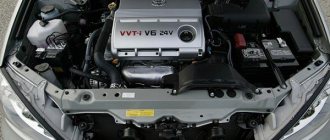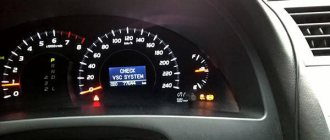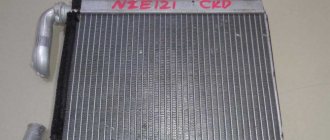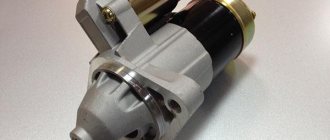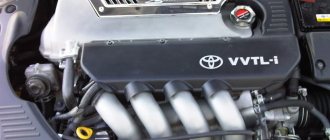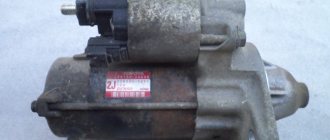Signs of a broken starter
So, how do you understand that it is the fault? This is indicated by 4 signs:
- The starter just won't turn over. The most common symptom of a breakdown, however, may also indicate problems with the battery.
- Clicking sounds are heard, but the crankshaft does not start. Directly indicates that the starter on the Toyota is broken. By the way, sometimes the relay itself does not work, then clicks will not be heard.
- The crankshaft starts, but rotates very slowly, and the engine does not start.
- Bendix squeaks gears, but there is no clutch with the crankshaft.
All this indicates that a starter revision or at least diagnostics is necessary.
Mechanical problems
Basically, mechanical problems manifest themselves in the fact that the starter works, but the crankshaft does not rotate.
However, there is one exception - worn out bearing shells.
In this case, the gap between the rotor and the stator winding may disappear and the starter will stop rotating altogether.
This failure is determined after removing the unit - just try to see if the rotor shaft moves in the sock.
If there is rotation, but it is not converted to the crankshaft, the following parts may be to blame:
- The rollers in the bendix clamping device were worn out.
- Bendix gear teeth are worn out.
- The feed fork is broken.
- Several teeth broke off on the engine flywheel crown.
A problem with the flywheel is identified by a grinding noise when starting up. It is especially typical when the flywheel begins to rotate and immediately stops spinning with a grinding noise.
Often the problem is a worn-out fork that has jumped out of place and does not push the bendix forward.
A powerful current is supplied to the starter, so the contact pins are exposed to significant spark corrosion.
After some time, their surface burns out, eventually leading to a lack of contact.
Burnt nickels of contacts.
Burnt contacts are the most common reason that the starter stops turning or sometimes rotates, sometimes not, but the relay operates properly.
For repair you need:
- Remove the relay cover; to do this, you need to unscrew the fasteners, remove the nuts on the copper bolts, you will also need to unsolder the contacts and flare the housing with a screwdriver.
- Using sandpaper, thoroughly clean the burnt contacts.
- In case of severe corrosion, the contacts are cleaned with an emery wheel or need to be completely replaced.
- It is enough to turn the contact plate on the rod with the smooth back side.
Sometimes a situation occurs when the starter does not turn off, but continues to work despite the open contacts in the ignition switch.
This is due to:
- The solenoid relay is stuck.
- Sticky contacts on the relay.
- Drive lever (stuck, falling off its mounts).
- The return spring has weakened or broken.
To repair it, you will have to turn off the engine and remove the unit for disassembly.
Usually you can find out about imminent problems with the starter in advance if you are careful.
The following symptoms may indicate a future breakdown:
- It is possible to turn on the starter only after several turns of the key. In this case, the sound of the solenoid relay is heard. It's time to clean the burnt contacts.
- The starter turns the flywheel with difficulty, but the battery is serviceable and well charged. Most likely, the brushes have worn out, the commutator unit has burned out, or the rotor has started to run out due to worn-out bearings.
- When the starter is turned off, it does not immediately disengage from the flywheel. The causes may be worn-out flywheel or bendix gear teeth, as well as a weakened return spring.
Why doesn't the car want to start?
As mentioned, most often the car does not start in the cold due to a discharged battery. Due to low temperatures, the battery drains much faster. The situation may arise suddenly. In the Corolla, the alarm system provides for blocking the starter unit if the charge drops below 10 V. In this case, it is enough to simply charge the battery or replace it with a new one.
Another common malfunction is the failure of the solenoid relay. This happens often on Toyota Corolla and the main symptom is the absence of a click when starting.
The relay is responsible for the flow of current from the battery to the starter, and if it is broken, the contacts do not close, as a result of which the engine cannot start. This is easy to check: just connect the starter directly to the battery. If it works, the problem is in the relay.
The third malfunction is wear of the bendix. Its teeth may wear out due to the natural “tiring” of the metal, which is not typical for 2008 cars. Forced grinding of gears is also possible. This can happen if you had to drive on the starter. In this case, only a complete replacement of the bendix will help.
Rarely, the reason why the car does not start may lie in the starter winding. If the current is exceeded, overheating occurs inside and the wire breaks. This leads to the fact that the turns of the winding begin to short-circuit with each other.
The problem is rare, but dangerous, because... the only solution is to completely replace the armature, which is almost the entire starter. The brushes also often wear out. In this case, it is enough to replace only them, which is inexpensive.
By the way, it’s easy to check the wear of the brushes - just hit them. As a rule, after this the starter starts working normally. At least there will be enough resource to get to the automagazine.
Electrical causes of failure
Failures of this type indicate that the starter either does not rotate at all or rotates reluctantly.
The first thing you need to check is the following:
- The battery is fully charged.
- The contacts from the battery and to ground are well tightened.
- All wires coming from the starter are not broken, there is no short circuit on them.
- The pull-down relay receives voltage and is grounded.
If you do not hear a click from the solenoid relay when you turn the key, then there is no voltage going to it, there is no ground, or the relay has failed.
If there is a click, but the starter does not spin or does it slowly, and the battery is well charged, then the part will have to be removed for inspection and disassembly.
The most common electrical faults:
- Worn brushes that do not fit tightly to the commutator ring.
- Burnt out collector.
- Solenoid relay malfunction.
- Short circuit or break in the stator or rotor windings.
Worn brushes in need of replacement.
Electrical problems are solved by replacing the broken unit. It is possible to repair the windings, relays, and rotor, but it will cost much more than replacement.
How to start a car if the starter does not turn
So, the car won't start, what can you do? It will not be possible to solve the problem with winding or wear of the bendix, but simple defects can be eliminated:
- The battery could die in the cold. In this case, a starter charger will help. You can also light a cigarette from another car.
- The wires may have oxidized. Inspect the contacts on both the starter and battery. If the contacts are oxidized, remove the corrosion with sandpaper. For prevention, you can coat the contacts with copper grease.
- If the brushes are worn out, hit them with a screwdriver or mallet. To do this, you will not need to remove the Toyota starter.
- The cables may have come loose. Also a common situation. Try tightening the bolts on the starter block and battery.
- Some batteries, usually non-original, basically cannot work properly in the cold. Even when fully charged, they go into defense and do not respond.
In an emergency, this is the only thing you can do. If none of the above recommendations work, a full repair is necessary.
The starter continues to operate after the engine starts
When the engine starts and you release the ignition key, the power supply to the traction relay stops and the bendix returns to its original position under the action of a spring.
If power continues to flow, this most likely indicates soldering of the main contacts in the solenoid.
The first thing to do is exclude the battery and generator from the list of possible causes.
Don't forget that the starter only works properly if the battery is fully (or sufficiently) charged.
Therefore, if the engine does not start, try starting it from an external power source using special connecting wires or use a jump starter.
After a successful start, it becomes clear that the problem lies in the electrical system.
Ways to solve problems that have arisen
First you need to understand how to remove the starter on a Toyota Corolla. It is secured with four bolts to the bottom bar. It is enough to unscrew them and also disconnect the power cables and contacts.
And here is where the starter is located. The only problem is that it is covered in bundles of wires that need to be carefully removed.
First, ring the winding contacts. There must be at least some resistance between them. If it is absent or close to zero, a winding break has occurred. In this case, the only option left is to replace the anchor.
If the starter works with a direct connection, then the problem is in the relay. It also needs to be replaced, but it will be much cheaper.
Next comes an inspection of the cables. In cold weather, they can freeze and burst, which leads to a short circuit or current leakage. It is also recommended to inspect them for soot. If you notice breaks or carbon deposits, simply change the cables.
This happens especially often in cold weather. First, the insulation freezes in the cold, causing it to become brittle and brittle. Then it heats up from the engine, which leads to the formation of microcracks. This way they become traumatized.
The problem is especially common on old Corolla Verso.
This problem is not typical for new revisions of Toyota Corolla, because Cable blocks are made of soft silicone that is not afraid of severe frost.
The principle of operation of the starter and its design
A starter is an electric motor with a drive that provides its connection to the engine rotor. Through it, the device spins the internal combustion engine.
The piston group begins to move, compression and ignition of the fuel mixture in the combustion chamber occurs. After this, the engine begins to work independently.
Modern starters are quite simple in design.
They consist of several parts:
- Housing with stator windings.
- Case toe (not on all models).
- Bendix.
- Rotor.
- Solenoid relay.
- Brush unit.
- Back cover.
- Fork.
- Some models also have a gearbox that increases the speed of rotation of the Bendix gear.
Starter device.
To start the engine, the driver first turns on the starter by turning the key in the ignition, starting the following chain of processes:
- When the contacts on the lock close, current is supplied to the starter solenoid relay.
- A magnetic field is excited in the relay, which draws the rod into the housing, compressing the spring.
- At the end of the rod there is a contact plate made of copper, which presses forcefully against the copper contacts, one of which is connected to the windings of the starter motor, and the second directly to the positive terminal of the battery.
- When the contacts are closed, current is supplied to the windings and the starter rotor is rotated.
- Simultaneously with the closure of the contacts, the retractor relay, using a fork, pushes the bendix forward, the gear of which engages with the teeth on the flywheel crown. The flywheel spins, the pistons begin to rotate and the engine starts.
- To prevent the starter from starting to slow down the engine after the engine starts, Bendix has a device that allows it to rotate only in one direction, slipping in the other. This allows the flywheel to spin freely, overtaking the rotation of the bendix.
- After turning off the starter by turning the key, the current supply to the relay windings is interrupted and the magnetic force disappears. The rod returns to its normal position under the influence of the return spring, which leads to the opening of the starter supply contacts and the removal of the Bendix gear from engagement with the flywheel ring.
Toyota Corolla Luxel › Logbook › Replacing the starter
Hi all! When I bought the car, it started up somehow sluggishly, I immediately expressed a brilliant idea about the starter. The seller assured me that he recently replaced the starter with a NEW ORIGINAL one. I took it to the service station and changed the spark plugs. We checked the pressure in the fuel rail, how many points the fuel pump pumps, and the compression. Everything is fine. I'm saying, maybe the starter is lousy? No, the guys say, everything is fine with the starter. Well, okay, and to hell with it. It’s just that on the previous Nissan the engine started right away, my father’s 1NZ also starts up briskly. Okay, the unit is no longer new. In short, he scored. A year passed, and it started: at first, the ring gear did not disengage from the crankshaft when it was cold. A couple more months passed: on the first try it didn’t start, then it started, I decided to take it off and see what was wrong with it. It turned out that everything was wrong with him! Not only that, the starter turned out to be CHINESE!
Judging by the licked bolts, it had also been repaired 500 times. I didn’t see any point in repairing it; when I looked into the store, I was completely depressed: the spare parts are expensive. For the sake of laughter and disgust, I asked how much a new Chinese starter costs: 5500! Contract - 6500! This is no good, these are the greedy hucksters we have in Achinsk. After calling Krasnoyarsk stores, I found a new original Japanese Toyota 28100-0D180.
Installed on Avensis and Corolla Verso. The seller said no piss, it will fit yours. By the way, the power is 1.3 kW. According to the catalog, I should have 28100-22030 0.8 kW or 28100-22040 1 kW. I don’t know how much the Chinese gave out, but he spun it very sadly. I was confused when installing, what if it doesn’t work? In vain, it turns briskly, I'm happy as an elephant. Now for the installation: I decided to install it through the top, to do this we remove the terminal from the battery and remove the chip from the Carlson.
Unscrew the two 10mm bolts and remove the casing with the fan. Next, we will be hindered by the throttle bar, which is secured with two 12mm bolts.
We finally remove the starter, two 14mm bolts. I used a small ratchet to get around everywhere. We install a new one and assemble it. When assembling, do not forget to stick the chip into the fan!

